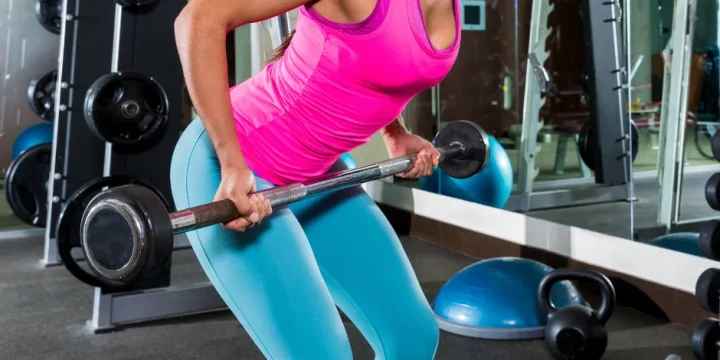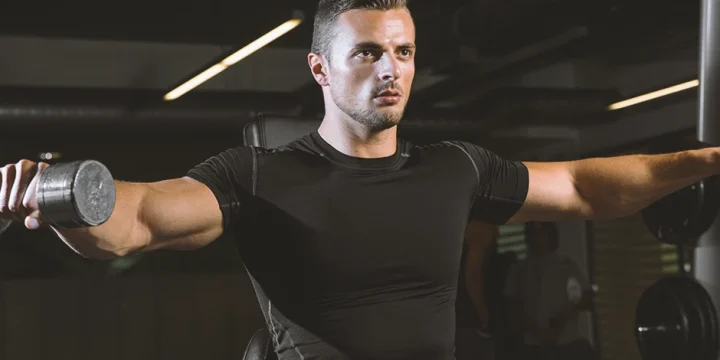Deltoid exercises are an essential component of any well-rounded workout routine.
These exercises help to increase your upper body strength and create a more chiseled and sculpted appearance.
As a personal trainer, I have dedicated weeks to conducting thorough research to put together a list of the best delt exercises you can include to target all three deltoid heads: the anterior, lateral, and posterior deltoids.
Quick Summary
- The best delt exercises include the lateral raise, face-pull, Arnold press, upright row, front raise, bent-over lateral raise, and shoulder press.
- The Arnold press is particularly effective for shoulder development, emphasizing maintaining a flat back and avoiding elbow lockout for better muscle isolation and injury prevention.
- According to WebMed, performing lateral raises with thumbs pointing downward can increase the risk of rotator cuff injury, highlighting the importance of proper form.
- In my opinion, incorporating a variety of delt exercises targeting all three deltoid heads is essential for achieving a balanced and aesthetically pleasing upper body physique.
The Best Delt Workout

1. Arnold Press
Tips:
- Maintain a consistently flat back against the pad throughout the entire exercise for better isolation of the shoulder muscles, stability, and injury prevention.
- Keep a slight bend in the elbows at the top of the movement and avoid complete lockout to effectively sustain shoulder tension.
To perform the Arnold press, follow these steps:
- Sit on an incline bench or chair with your feet firmly planted on the floor.
- Grasp a dumbbell in each hand, with your palms oriented toward your body.
- Raise the dumbbells to shoulder level and rotate your palms away from your body.
- Press the dumbbells up overhead, but instead of stopping directly above your head, allow your elbows to flare out to the sides. As you press the weights up and outwards to the sides, rotate your palms to face your body again at the top of the movement.
- Gradually lower the weight back down to the starting position, simultaneously rotating your palms to return to the starting position as you do so.
- Repeat for the desired number of repetitions.
2. Lateral Raise
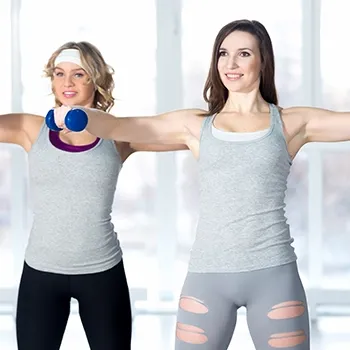
This exercise isolates the posterior deltoid, which aids in the outward rotation and extension of the upper arm bone, known as the humerus.
Tips:
- Avoid swinging your arms and prioritize slow, controlled motions.
- Lead the movements with your elbows rather than your hands.
- Avoid letting your thumbs point downward, as according to WebMD, it can increase the risk of rotator cuff injury [1].
- Don’t lift the dumbbells above your shoulder level.
Follow these steps for performing the lateral raise exercise:
- Stand with your feet shoulder-width apart, while keeping your knees slightly bent.
- Grasp a dumbbell in each hand, with your palms facing your thighs.
- Slowly lift the dumbbells up and out to the sides, keeping your palms facing the ground.
- Continue to raise the dumbbells until they reach about shoulder height, keeping your elbows slightly bent.
- Slowly lower the dumbbells to your thighs.
- Repeat for the desired number of repetitions.
Related: Cable Lateral Raise Guide
3. Upright Row
Tips:
- Keep your back straight throughout the exercise.
- If you encounter any discomfort, decrease the range of motion. According to a study from Sage Journals, it is preferable to prioritize a wider range of motion with lighter weight over heavier weight with a limited range [2].
- Control the weight as it lowers instead of allowing gravity to take over.
- Refrain from arcing the bar away from your body. Instead, maintain proximity by elevating your elbows upward rather than outward.
To perform the upright row, follow these steps:
- Stand with your feet shoulder-width apart and your knees slightly bent.
- Grasp the barbell with an overhand grip, ensuring your hands are shoulder-width apart.
- Raise the barbell towards your chin while keeping it close to your body and allowing your elbows to flare out to the sides.
- Pause for three seconds at the top of the movement, then slowly lower the weight back to return to the starting position.
- Repeat for the desired number of repetitions.
“Avoid arcing the bar out from your body and instead, keep it close to you by raising your elbows up instead of out. Keeping the bar closer will help activate all the muscles in your shoulder correctly, including your side delts, which won't be activated as much if you arc the bar away from you.”
- Paul Rogers, Certified Personal Trainer
4. Front Raise
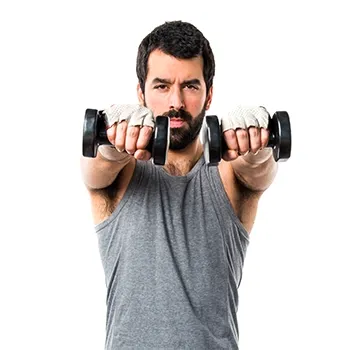
Tips:
- Avoid rocking when performing this lift. If you can’t keep a stationary torso, use a lighter weight.
- Avoid using momentum to lift the weights, as it can diminish muscle tension, particularly at the top of the movement.
- Do not use excessive weight, as it can put stress on the shoulder joints and cause injury.
To perform this exercise, follow these steps:
- Stand with your feet shoulder-width apart and your knees slightly bent.
- Grasp a dumbbell in each hand with your palms facing your thighs.
- Slowly lift the dumbbells up and in front of your body, keeping your palms facing down.
- Continue to raise the dumbbells until they reach about shoulder height, keeping your arms straight.
- Pause for three seconds, then slowly lower the dumbbells to your thighs.
- Repeat for the desired number of repetitions
5. Shoulder Press
Tips:
- Use weights that allow you to complete the full range of motion.
- Keep your shoulder blades down.
- Instead of pushing up explosively, focus on pressing the weights in a slow and smooth manner.
To perform this exercise, follow these steps:
- Begin by sitting on a bench or standing straight with your feet shoulder-width apart.
- Grasp a dumbbell in each hand with your palms facing forward and your elbows bent at a 90-degree angle, holding the weights at shoulder height.
- Slowly raise the weight above your head until your arms are fully extended.
- Pause for three seconds, then slowly lower the dumbbells to shoulder height.
- Repeat for the desired number of repetitions.
6. Dumbbell Bent-Over Raise
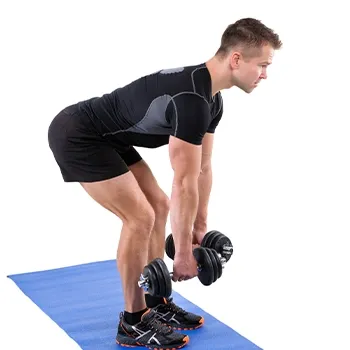
Tips:
- Choose a weight that lets you maintain complete control of your body throughout the entire movement.
- Maintain a straight back as you hinge your hips forward.
To target the rear deltoids effectively using this exercise:
- Stand with your feet hip-width apart and grasp a dumbbell in each hand.
- Bend over at the hips so your upper body is parallel to the floor while keeping your back straight.
- Let the dumbbells hang straight down from your shoulders.
- Slowly raise the dumbbells to the sides until they reach about shoulder height, keeping your elbows slightly bent and your palms facing the floor.
- Pause at the top of the movement, then slowly lower the weight to return to the starting position.
- Repeat for the desired number of reps.
Related: Best Upper Body Dumbbell Workout for Toning Your Muscles
7. Face Pull
Tips:
- Avoid pulling the rope toward your neck, as it will activate the biceps instead of the rear delts.
- Don’t select a heavy weight for this exercise, as the rear delts are a small muscle group.
To perform this exercise:
- Attach a rope to a cable machine at chest height.
- Position yourself facing the cable machine and firmly grasp the rope with both hands, ensuring your palms face down.
- Take a few steps back to create tension on the rope, then stand with your feet shoulder-width apart and maintain a slight bent in your knees.
- Bring the rope towards your face by pulling your elbows to the sides of your face. While pulling the rope, focus on squeezing your shoulder blades together, and continue the motion until your hands reach the sides of your head.
- Pause for three seconds at the top of the movement, then slowly release to return to the starting position.
- Repeat for the desired number of reps.
“If you find you're using momentum to pull the attachment toward your body, or if you can't control the weight as it returns to the stack, pulling your body forward, then you should probably reduce the amount of weight you're trying to lift.”
- Laura Williams, Fitness Expert
Related articles:
What Are the Benefits of Delt Exercises?

As a personal trainer, I've seen firsthand how delt exercises benefit my clients by strengthening their shoulder muscles, enhancing stability, and significantly reducing their risk of injury.
- Improved posture - Well-developed deltoid muscles contribute to keeping the shoulders back and down, resulting in improved posture and a reduced risk of shoulder injuries.
- Increased shoulder stability - Strong deltoid muscles help to stabilize the shoulders, facilitating everyday activities such as lifting, reaching, and pulling.
- Reduced risk of injury - Strengthening the deltoid muscles can improve overall shoulder joint stability, reducing the likelihood of injuries to the shoulder and surrounding areas.
- Decreased shoulder pain - According to a study from the Journal of Orthopaedic and Sports Physical Therapy, shoulder exercises are as effective as shoulder injections and surgery [3].
- Increased muscle definition - Training the deltoid muscles (the anterior deltoids, lateral deltoids, and posterior deltoids) creates a more defined and sculpted appearance in the upper arm area.
- Improved upper body aesthetic - Strong and well-defined delts enhance the overall aesthetic of the upper body, creating a more balanced and visually attractive physique.
- Enhanced overall athletic performance - Strong shoulder muscles improve upper-body strength and power, crucial for excelling in sports and other physical activities.
Related: Best Middle Delt Exercises
How to Include Delt Exercises in Your Workout?

I've found these tips highly effective when incorporating deltoid exercises into my clients' workout routines:
- Determine optimal training frequency - Based on your fitness level and goals, decide whether to train your deltoids once or twice a week.
- Select a variety of exercises - Target all three heads of your deltoids by including exercises such as overhead press, lateral raise, bent-over lateral raise, and face-pulls.
- Plan strategically - Avoid overtraining or undertraining by strategically planning your workouts. You can dedicate an entire session to deltoid exercises or integrate them as accessory movements in your program.
- Vary reps and sets - Prevent plateaus and maintain motivation by incorporating variety into your workouts. Change up your reps, sets, and exercises regularly.
- Prioritize proper form - Focus on executing deltoid exercises with correct form and technique. Maintain proper posture and engage the correct muscles throughout each exercise.
Recovery and Deltoid Care
Effective recovery is crucial for healthy deltoid muscles.
- Stretching post-workout can enhance flexibility and reduce muscle tightness, particularly in the shoulder area. It's important to focus on stretches that target the deltoids and surrounding muscles.
- Foam rolling is another excellent tool, aiding in breaking down knots and promoting blood flow to the deltoids, which can accelerate recovery and reduce soreness.
- Additionally, rest days are essential; they allow the deltoid muscles to repair and grow stronger.
- Overtraining can lead to injuries, so incorporating rest days into your routine ensures your deltoids recover fully, maintaining their health and functionality.
FAQs
What Are the Best Deltoid Exercises?
The best deltoid exercises are lateral raises, Arnold presses, face pulls, dumbbell bent-over raises, shoulder presses, front raises, and upright rows.
How Many Reps Should You Do for Delts?
You do eight to twelve sets of delts per set if your goal is building muscle mass. However, if you want to increase endurance, aim for higher rep ranges (twelve to twenty per set).
References:
- https://www.webmd.com/fitness-exercise/how-to-do-lateral-raises
- https://journals.sagepub.com/doi/10.1177/2050312120901559
- https://www.jospt.org/doi/10.2519/jospt.2020.0501
About The Author
You May Also Like




